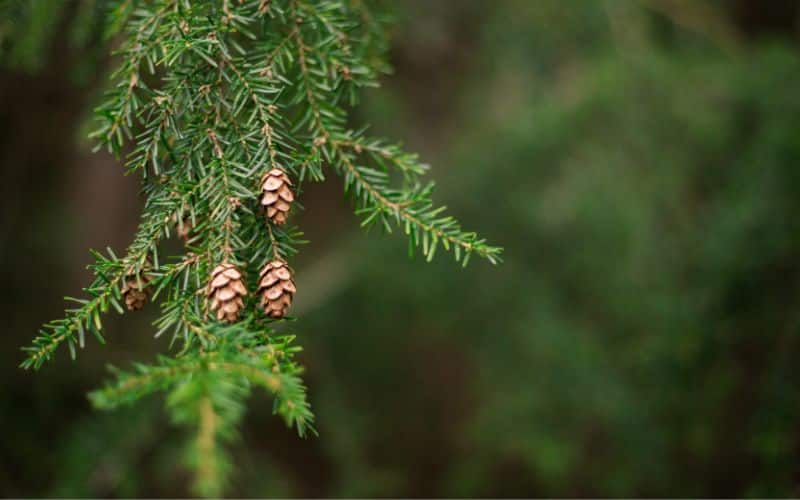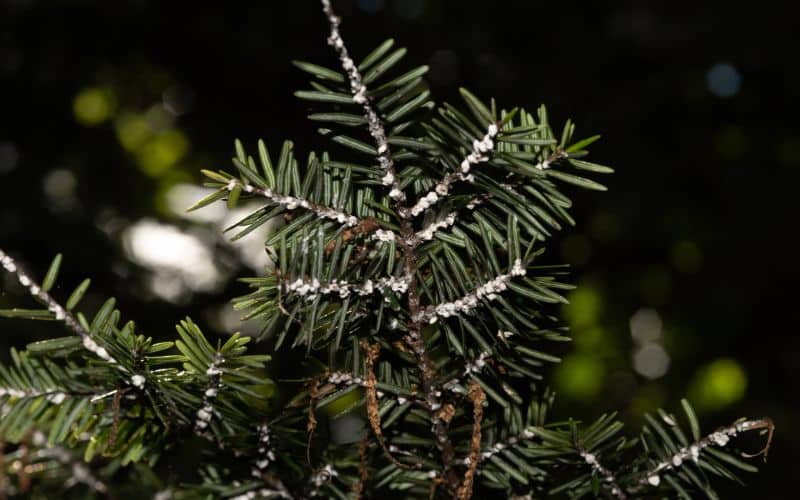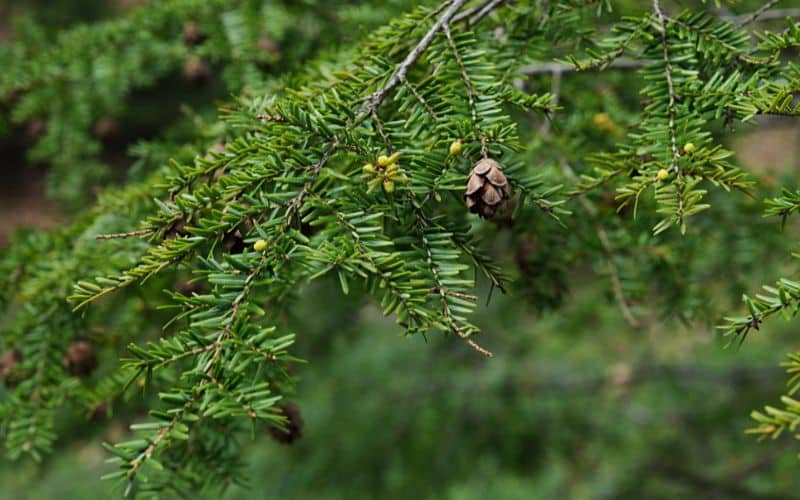
The Eastern Hemlock’s Place in Ontario’s Ecology
Picture this: the Eastern Hemlock, an evergreen conifer that stands as a living testament to Ontario’s rich natural heritage. Known to the scientific community as Tsuga canadensis, this tree has graced Southern Ontario’s forests for countless generations. Yet, even age-old stalwarts have their nemeses. Enter the Hemlock Woolly Adelgid, a villainous insect that threatens to rewrite the Eastern Hemlock’s long-standing narrative.
What Makes the Eastern Hemlock Unique?
The Eastern Hemlock is not your run-of-the-mill conifer. Its needles are attached to the twig by a small stem, giving it a unique appearance. The underside of each needle is marked by two white bands, contrasting with its shiny green upper surface. This tree is a master of adaptation, thriving in the shade and adding a touch of evergreen beauty to Ontario’s diverse habitats.
The Anatomy of the Eastern Hemlock: From Twig to Cone
At first glance, the Eastern Hemlock might seem like just another tree in the forest, but a closer look reveals a marvel of natural engineering. The tree’s needles, far from being haphazardly arranged, follow a spiral pattern around the twig. But here’s the twist—literally. These needles contort themselves to lie in two distinct, flat rows. It’s as if nature itself decided to give this tree a unique architectural flair.
But the design genius doesn’t stop there. The Eastern Hemlock also produces petite seed cones that are essential for its survival. Measuring just 1-2 cm in length, these cones perch on hairy stalks, making them stand out like crown jewels on a royal robe.

How Do Seed Cones Contribute to Hemlock Reproduction?
When it comes to the Eastern Hemlock’s life cycle, the seed cones are the unsung heroes. These tiny structures house the seeds that are the future of the species. But it’s not just a matter of holding seeds; it’s about launching them into the world. When the time is right, the cones unfurl like a flower greeting the sun, releasing their seeds into the wild. These seeds then embark on journeys of their own, carried by the wind or hitching a ride on forest animals. Once they land in the moist, fertile soil of a hospitable habitat, they germinate, giving rise to a new generation of Eastern Hemlocks. It’s a cycle as old as the hills, but one that ensures the tree’s continued presence in our landscapes.
Eastern Hemlock Habitats: Where Do These Trees Thrive?
Eastern Hemlocks are not picky when it comes to their living conditions. They prefer cool, shady, and moist environments, often found on lower slopes and in valleys. This makes them a common sight in Southern Ontario, where they add to the region’s dense forest cover.
The Ecological Role of the Eastern Hemlock: More Than Just a Tree
The Eastern Hemlock is far from being a mere ornament in the forest; it’s an ecological linchpin. With its dense branches, it serves as a natural sanctuary, offering shelter to a menagerie of wildlife. Birds find refuge in its boughs, while mammals like snowshoe hares and white-tailed deer find it an ideal hiding spot. But the tree’s role doesn’t end at providing shelter; it’s also a food source. Its needles are a delicacy for some insects, and the small seed cones are a feast for various bird species. In essence, the Eastern Hemlock is a bustling hub of activity, a cornerstone that holds its habitat together like glue.

What Threats Does the Hemlock Woolly Adelgid Pose?
Cue the ominous music; it’s time to talk about the dark cloud hanging over the Eastern Hemlock—the Hemlock Woolly Adelgid. This minuscule insect is a force to be reckoned with. It attaches itself to the base of the tree’s needles and begins to feed on its sap. The result? A weakened tree that’s more susceptible to diseases and environmental stress. But the woolly adelgid’s impact goes beyond the individual tree; it threatens the entire ecosystem. When Eastern Hemlocks die, the animals that depended on them for shelter and food are left in the lurch. The loss of these trees can lead to a domino effect, destabilizing the habitats they once anchored. It’s not just a tree at risk; it’s an entire ecological web hanging in the balance.
How Does the Woolly Adelgid Affect Eastern Hemlock Health?
The woolly adelgid’s impact on the Eastern Hemlock is devastating. The insect attaches itself to the base of the needles, draining the tree of its essential nutrients. Over time, this leads to needle loss, reduced growth, and in severe cases, the death of the tree. The loss of these trees has a ripple effect on the habitats they support, leading to ecological imbalances.
Combating the Woolly Adelgid: What’s Being Done?
The fight against the woolly adelgid is akin to a high-stakes chess game, and Ontario is making strategic moves to protect its beloved Eastern Hemlocks. A multi-pronged approach is in play, involving everything from chemical warfare to biological allies. Insecticides are one line of defense, targeting the woolly adelgid directly to halt its sap-sucking spree. But chemicals alone won’t win this war.
Biological controls are also entering the fray. Researchers are exploring the use of natural predators to keep the woolly adelgid population in check. Think of it as enlisting the help of nature’s own bounty hunters. These methods are still in the experimental stage, but early results are promising.
It’s a complex and challenging battle, no doubt. Yet, the resolve to save the Eastern Hemlock and preserve Ontario’s ecological balance is stronger than ever. Teams of scientists, conservationists, and even everyday citizens are joining forces in this critical mission. The fight is tough, but surrender is not an option.

The Future of Eastern Hemlock in Ontario: What Does Ecology Tell Us?
The Eastern Hemlock is a resilient species, but it faces an uphill battle against the woolly adelgid. The tree’s ability to thrive in diverse conditions, from shady slopes to moist valleys, gives us hope for its future. However, active intervention is needed to ensure that this conifer continues to be a part of Ontario’s rich ecological tapestry.
Conclusion: The Eastern Hemlock and Its Fight for Survival Against the Woolly Adelgid
The Eastern Hemlock is more than just a tree; it’s a symbol of Ontario’s rich natural heritage. Its unique needles, conical shape, and the slight droop of its branches make it a sight to behold. But the tree’s survival is threatened by the woolly adelgid, an insect that could change the face of our forests forever. As we continue to study and protect this magnificent species, let’s not forget the vital role it plays in our ecosystems and the urgency to protect it for future generations.








